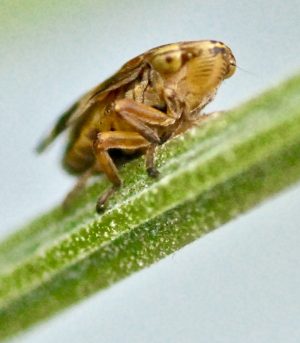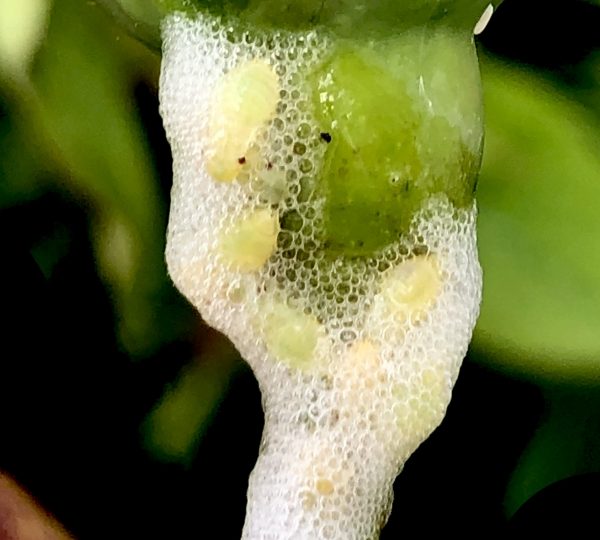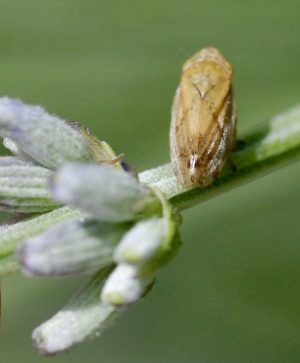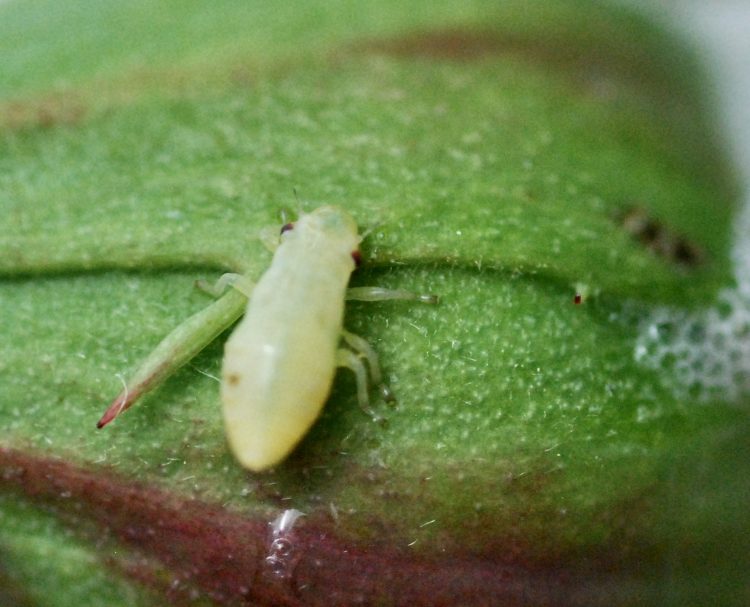Spittlebug Survey 2020

In 2019, the blog reported on the disease that has been destroying the olive groves of Italy, and that is spreading in Europe.
The following is an appeal from the research scientists investigating the distribution of spittlebugs in the UK. It was launched in 2020.
NOTE : this survey / citizen science project has now ended.
Spittlebug Survey 2020
Did you know that the ‘cuckoo-spit’ that you see in spring is produced by the immature stage (nymph) of a spittlebug or froghopper? It is thought that the spittle is produced to protect the nymphs from drying out and from their predators.
Once the nymphs emerge as adults, usually in late June, they leave their spittle ‘nest’ behind and become free-flying. The name froghopper reflects the fact that their face is rather bulbous and therefore froglike, and that they are one of the most powerful jumpers in the animal kingdom. There are ten species of froghopper in Britain. The so-called Meadow Spittlebug, Philaenus spumarius, is one of our commonest insects and has possibly the broadest diet of any insect, being known to feed on more than 400 species of plant.

Spittlebugs on Rose
Interest in these insects has recently been heightened by the fact that they all feed on the liquid contents of the plant xylem tissue and are therefore capable of transmitting various plant diseases that reside there. One of these, the bacterium Xylella fastidiosa, has recently been responsible for the death of millions of olive trees in southern Italy.

We need to collect good data on two aspects of these insects to understand better how the Xylella bacterium would spread if it were ever introduced into Britain:
- the geographical distribution of the different species of spittlebug and
- the plant species that they feed on.
Last year, we started to collect some of this information through a national survey, funded by the Biotechnology & Biological Sciences Research Council (BBSRC) and coordinated through the RHS, focused on gardeners recording spittle on their garden plants. This year, the current restrictions on movement due to the coronavirus mean that extending the survey into the wider countryside will not be possible. But if you have a garden, you will be able to record the presence of cuckoo-spit on the plants in the garden.
Can you help?
It will mean recording cuckoo-spit when you find it in your garden and especially the plant species on which you find it. Please consider contributing to this important survey.
Much more information and an online form for submitting your sightings can be found on the spittlebug website at: www.Spittlebugsurvey.co.uk
If interested, there is is a page to help identify the different species of insects - here ; and the video (above) will also help with this. To report a sighting, visit this page : https://www.spittlebugsurvey.co.uk/how-to-survey-for-xylem-feeding-ins
Please let us know
- where you saw it,
- when you saw it, and (if possible)
- the species of plant on which it was found.
We also ask you to add at least one photograph of your find.
NB : Please be sure to follow the government’s instructions to stay at home during the coronavirus emergency. We can only accept records from people’s gardens whilst the current restrictions are in place. The above material supplied by the BRIGIT research consortium
PLEASE NOTE
The original survey was in 2020, it is now complete.
The web site has now been deleted.
There is also some information available at the RHS site : https://www.rhs.org.uk/science/help-our-research/spittlebug-survey

Comments are closed for this post.
Discussion
The original survey was in 2020, it is now complete.
The web site has now been deleted.
Tried to record my sighting (16/6/22) but apparently the domain site “was not registered yet”. Not helpful guys.
Tried to report spittlebug sighting but failed because I haven’t a clue what the taxon is. I am not a biologist!!
I have the spittle on my plant’s in the garden in Manchester but haven’t seen the actual bug.
True, they do little damage – as it says in original blog (https://www.woodlands.co.uk/blog/flora-and-fauna/xylella-froghoppers-and-spittlebugs/) : “Spittle bugs aka froghoppers are not plant pests as such, but it is important to know about their geographical distribution and the plants that they are found on just in case the Xylella bacterium makes it across the channel and becomes a threat to plants in the U.K.”
But the survey is important in case the bacterium makes its way across the channel.
Other than looking unsightly, spittlebugs do very little damage to a plant. They do suck some of the sap from the plant, but rarely enough to harm the plant – unless there are huge numbers of them. I have collected plants that was damage by these spittle bugs and not that was harm a lot. So I made my plants checked at least 2 to 3 times a day.
I’m really please that I stumbled upon this article, it’s really insightful and a great quick read might I add too! Great photos by the way especially the look of the macro shots, perfect!
If I ever come across a cuckoo-spit in my garden or those of my friends I will keep that survey in mind. I will keep an eye out for them and hope I find some of my own in my garden even as I hope to landscape it with http://www.landscapingsolihull.com
Best of luck and all the best with future articles!

The original survey was in 2020, it is now complete.
The web site has now been deleted
Blogs
19 June, 2022